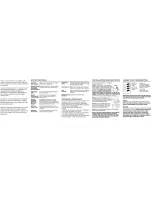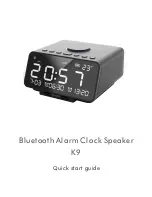
Specifications:
Features:
SMOKE ALARM R10RF
Photoelectric Smoke Alarm with 10 Year Lithium Battery & Wireless Connection
PLEASE NOTE:
READ ALL INSTRUCTIONS BEFORE INSTALLATION. NO USER SERVICEABLE PARTS INSIDE THIS SMOKE ALARM.
Main Power Source
Sensing Type
Sensitivity to smoke
Operation Current
Temperature Range
Humidity Range
Interconnecting
RF Range
Pairing duration
Sound Level
Alarm Condition
Visual Indicators
Approval
• DC operated photoelectric type smoke alarm
• Photoelectric sensor for slow smouldering fires
• Wireless Interconnection
• Insect proof
• Test & Hush button
• Environmentally friendly non-radioactive
technology High and stable sensitivity
• Quick fix mounting bracket for easy installation
• Fitting and battery tamper-resist feature LED
operation indicator
• Extra loud alarm sound over 85 dB
• Low-battery and battery missing warning
indicators
• Auto reset when smoke clears
lithium 10 Year 3V Sealed-Battery
Type A Photoelectric smoke alarm
- contains NO radioactive material
0.08-0.2db/m
<
20mA operation (In Alarm)
0 °C to 45 °C
0% to 95% RH
40 alarms for wireless interconnection
100 m free air
30 m indoors (line of sight)
2 min (recount after each success pairing)
85 dB at three metres minimum
Audible signal pattern (ISO 8201)
Red LED for warning and low battery indication
AS 3786:2014, Activefire
Locating and Positioning of Smoke Alarms:
Installation of Smoke Alarms:
1. From back of the smoke alarm, remove the mounting plate by
turning it counterclockwise. (To later engage tamper-resist feature,
twist out and set aside one of the pins moulded into plate. Both pins
are exactly the same).
2. Position smoke alarm to mounting plate and turn clockwise to lock
into place. To engage tamper-resist feature, insert pin into notch and
edge of smoke alarm after alarm is properly positioned in base.
3. Push test button to test smoke alarm.
WARNING:
Incorrect orientation will result in a decrease in
operational effectiveness.
This smoke alarm is a single station photoelectric alarm and should NOT be connected to other smoke alarms.
If your dwelling is on a single storey, for minimum protection you should fit an alarm in the hallway between the
living areas (incl. Kitchens) and sleeping areas. Place it as near to the living areas as possible and ensure the alarm
is audible when the bedrooms are occupied.
If your dwelling is multi-storey, for minimum protection one alarm should be fitted at the bottom of the staircase
with further alarms fitted on each upstairs landing. This includes basements but excludes crawl spaces and
unfinished attics.
NOTE:
For maximum protection an alarm should be fitted in every room (except kitchen, bathroom and garage).
DO NOT FIT AN ALARM IN THE KITCHEN or BATHROOM, as cooking fumes or steam may trigger the alarm.
DO NOT FIT ALARM IN A GARAGE, as exhaust fumes are likely to set it off.
Ceiling Mounting
As hot smoke rises and spread out, it is advisable to mount on a ceiling in a central position. Avoid areas where
there is no air circulation. E.g. Corners of rooms and keep away from items which may prevent the free flow of air.
Place the unit at least 300mm from and light fitting or decorative object which might obstruct smoke / heat
entering the alarm. Keep at least 300mm away from walls. See Figure 3i.
Wall Mounting
Do not mount tight into the corners. Put the top edge of your smoke alarm between 150 and 300mm below the
ceiling. Keep at least 300mm from room corners. See Figure 3i
On a Sloping Ceiling
In areas with sloping or peaked ceilings install your Smoke Alarm 900mm from the highest point measured
horizontally because “dead air” at the apex may prevent smoke from reaching the unit. See Figure 3ii.
MULTI-STOREY RESIDENCE
HALL
BED
ROOM
BED
ROOM
KITCHEN
BASEMENT
LIVING
ROOM
CEILING / WALL JUNCTION
CEILING
ACCEPTABLE HERE
BEST
HERE
NEVER
HERE
HEAT &
SMOKE
FROM
FIRE
DEAD AIR
SPACE
SIDE WALL
300mm min
300mm mi
n
600mm mi
n
APEX OF
SLOPING
CEILING
HEAT & SMOKE
FROM FIRE
DEAD
AIR SPACE
1500mm max
500mm mi
n
500m
m m
in
BEST
HERE
BEST
HERE
Smoke alarms for minimum protection.
Smoke alarms for additional protection.
Smoke alarms with hush features
recommended for additional
protection
SINGLE-STOREY RESIDENCE, APARTMENT, MOBILE HOME
BEDROOM
BEDROOM
BEDROOM
W/C
KITCHEN
DINING
BATH
LOUNGE ROOM
IMPORTANT:
This manual contains important information about the installation and operation of your smoke alarm. Please read carefully before installation
and keep for future reference. Please ensure that this leaflet remains in the household where the alarm is installed.
WARNING:
This smoke alarm is designed to alert you to the presence of smoke. It cannot prevent a fire. There are hazards against which smoke alarms may
not be effective such as smoking in bed, explosions, etc. The ultimate responsibility for fire protection rests with you. This responsibility includes escape
planning, safety checks and an effective warning system. In case of fire, a well-placed, properly looked after smoke alarm may provide a few seconds so that
you can escape and call the fire brigade.
IMPORTANT SAFETY INFORMATION
1. The battery must be operational to operate the alarm
correctly. To test the battery press the test button on this
smoke alarm.
2. The test button accurately tests all smoke alarm
functions. DO NOT use any other test method.
3. DO NOT remove or disconnect battery to silence
unwanted alarms. This will remove your protection. Press
hush button or open windows to ventilate the smoke
alarm to silence it.
4. This smoke alarm is designed to be used inside a single
unit dwelling only. In buildings with several dwellings,
each individual living unit should have its own smoke
alarms. DO NOT install in non-residential buildings.
5. Install a smoke alarm in every room and on every level
of the home.
6. Smoke alarms can only sound their alarms when they
detect smoke. Smoke alarms detect combustion particles
in the air. They do not sense heat, flame or gas. This
smoke alarm is designed to give an audible warning of a
developing fire. However, many fires are fast burning,
explosive or intentional. Others are caused by careless-
ness or safety hazards. Smoke may not reach the smoke
alarm quickly enough to ensure safe escape.
7. Smoke alarms have limitations. This smoke alarm is
not foolproof and is not warranted to protect lives or
property from fire. Smoke alarms are not a substitute for
insurance. Homeowners and renters should insure their
lives and property. In addition, it is possible for the smoke
alarm to fail at any time. For this reason, you must test
the smoke alarm weekly and replace every 10 years.
Turn clockwise
to install
Turn counterclockwise
to uninstall
Monuting Plate
Alarm Unit
Wireless Connection Setup Guide:
1. Complete installation and turn on the mains power supply.
2. Select one of wireless bases as the MASTER unit. Place the MASTER label near the wireless pairing button.
Treat all other units as BRANCH units.
3. On the MASTER wireless base, by hand, press and hold the wireless pairing button for 5 seconds. The unit is
now in self-learn pairing mode indicated by the LED remaining on for 30 seconds.
NOTE:
To exit self-learn pairing mode, press the wireless pairing button one time. The Red LED will turn off.
4. While the MASTER unit’s LED is on, press the wireless pairing button 2 times quickly (within a second) on
the BRANCH wireless base. The Subordinate unit’s LED will flash 5 times indicating successful interconnec-
tion.
NOTE:
If the BRANCH units does not flash its LED 5 times but stays ON, the wireless interconnection has
failed. In this case, check the range or reduce the distance between units and make sure the MASTER unit’s
LED remains ON while operating the BRANCH unit.
5. Repeat step 4 on all other BRANCH units.
6. After all units has been paired. Press Test button and hold MASTER unit’s Test button for 2 seconds to do
the Test/Hush function.
7. Press and hold MASTER unit’s wireless Pairing button for more than 8 seconds. Check all other wireless
interconnected unit receive the RF signal and alarm sounds.
SMOKE ALARMS
INSTALLATION INSTRUCTIONS




















